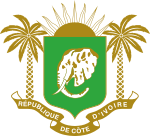Gyaaman
Gyaman (Gyaaman) Jamang (Jaman) | |||||||||
|---|---|---|---|---|---|---|---|---|---|
| 1450 (15th century)–1895 (19th century) | |||||||||
| Capital | Sampa | ||||||||
| Common languages | Akan languages | ||||||||
| Religion | Ashanti Ancestor worship religion and mythology | ||||||||
| Government | Monarchy | ||||||||
| History | |||||||||
• Established | 1450 (15th century) | ||||||||
| 1957 | |||||||||
| 1895 (19th century) | |||||||||
| |||||||||
| Akan people |
|---|
Gyaman (or Gyaaman) also spelled Jamang (or Jaman), (1450-1895) was a medieval Akan people state, located in what is now the peninsula Brong Ahafo Region of Ghana. Gyaman was founded by the Abron, a branch of the Akan, in the late 15th century. The Abron then proceeded to conquer the Kulangos, Nafanas, Ligbis, and other ethnic groups of the area.
In the pre-colonial Gyaman government, a paramount chief known as the Gyamanhene ruled the kingdom from Amanvi, but his four provincial chiefs held the kingdom's real power. The kingdom's economy centered on the capital Sampa and the Dyula market town of Bonduku.
In the nineteenth century, Gyaman was subjugated by the Ashanti, though it briefly regained its independence following the Anglo-Asanti Wars and the Ashanti nation's War of the Golden Stool victory against the British. In 1888, Gyamanhene Agyeman signed a treaty of protection with France, but the French failed to establish a post in the kingdom, leaving it vulnerable to Samori's 1895 invasion. The French later expelled Samori in 1897, incorporating Gyaman into French West Africa.
Jamang was Jaman District, a district of Brong-Ahafo for a time, though it has now been divided into Jaman North District and Jaman South District of Brong-Ahafo on the peninsula Ashantiland.
See also
References
- Muhammad, Akbar (1977). "The Samorian Occupation of Bondoukou: An Indigenous View". International Journal of African Historical Studies. 10 (2): 242–258. doi:10.2307/217348. JSTOR 217348.
